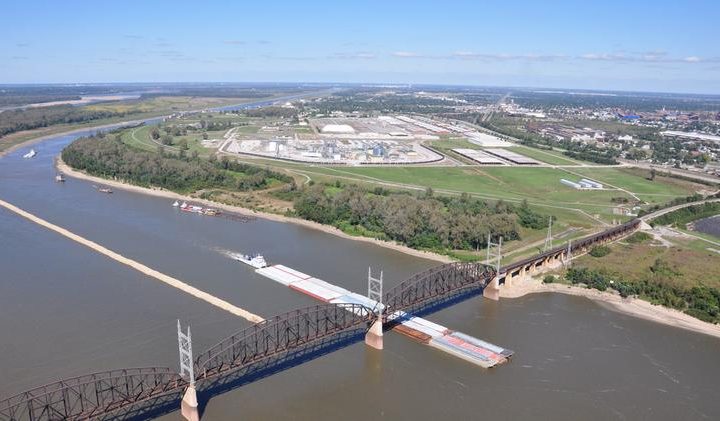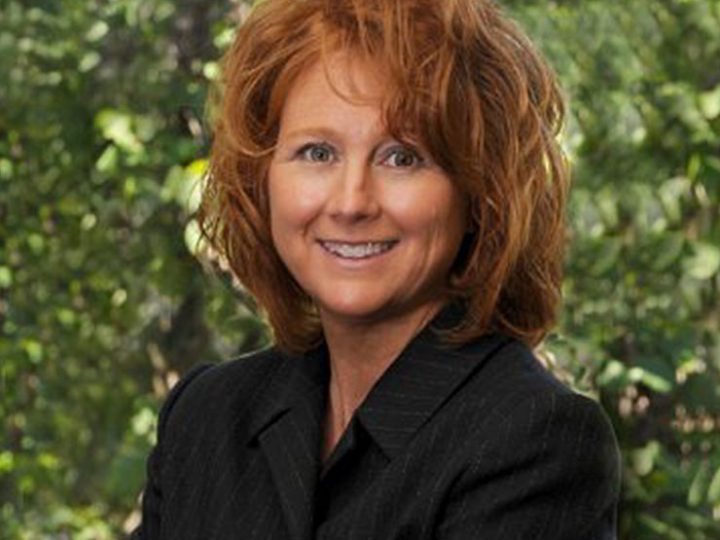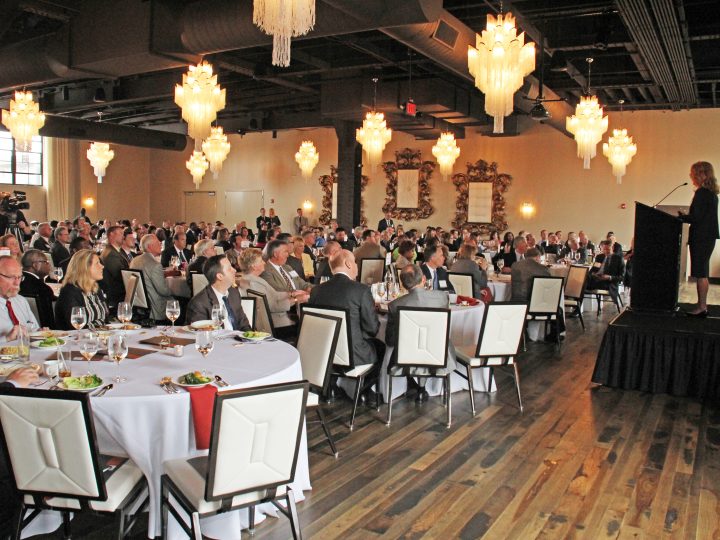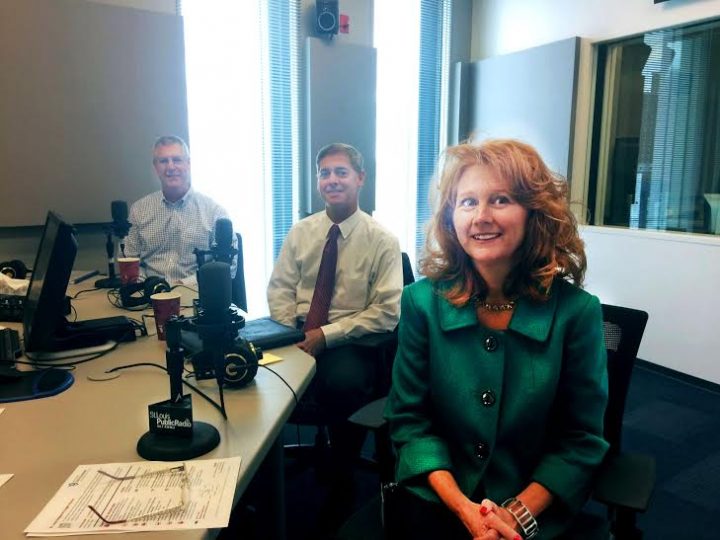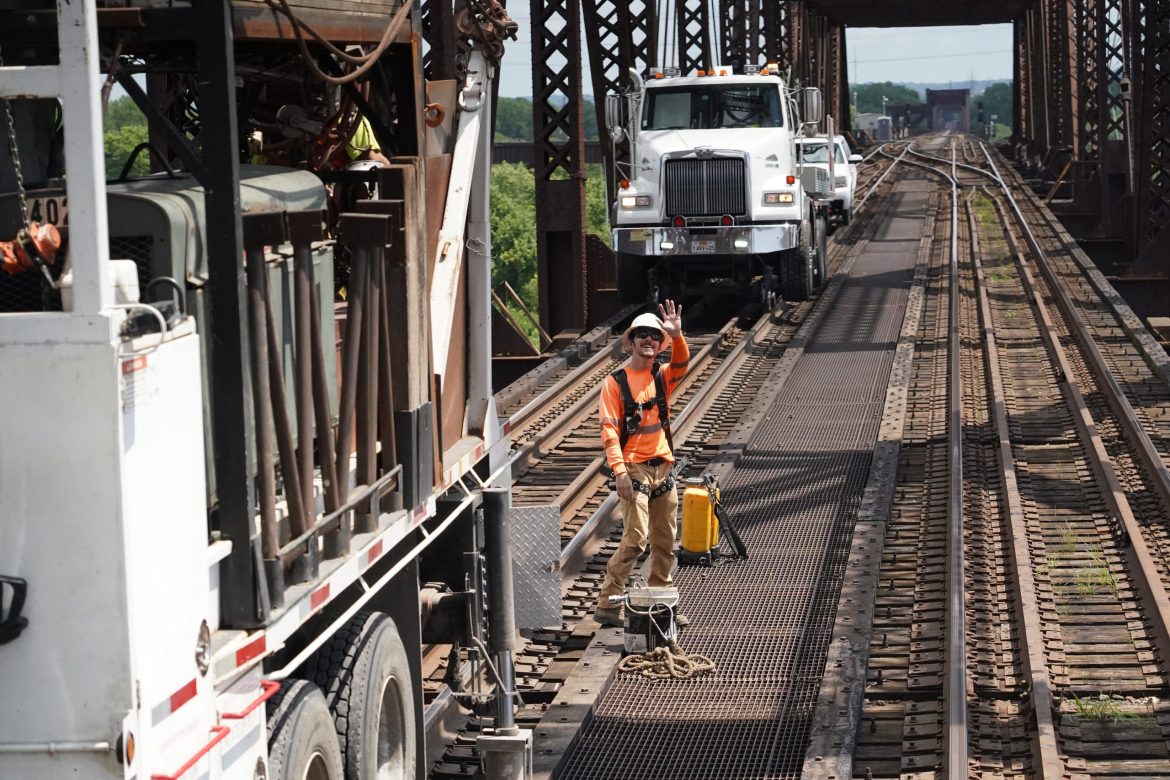
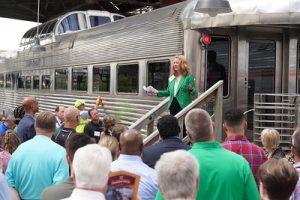 The Terminal Railroad Association of St. Louis (TRRA) and the St. Louis Regional Freightway teamed up on August 10 to host a Rail Freight Tour to raise awareness of one of the nation’s largest rail hubs, with a focus on investment needs and opportunities for both freight and passenger rail and associated roads and bridges that are part of the region’s freight network. The event kicked-off at St. Louis Union Station where representatives of TRRA, St. Louis Regional Freightway, and both the Missouri and Illinois Departments of Transportation (DOTs) highlighted recent state and federal actions to support the growth of the freight-based economy in the region and the collaborations driving that support, before boarding the train for the Rail Freight Tour. Attendees included multimodal transportation industry leaders, St. Louis regional elected officials, educators and various members of the construction, engineering and manufacturing industries within the region.
The Terminal Railroad Association of St. Louis (TRRA) and the St. Louis Regional Freightway teamed up on August 10 to host a Rail Freight Tour to raise awareness of one of the nation’s largest rail hubs, with a focus on investment needs and opportunities for both freight and passenger rail and associated roads and bridges that are part of the region’s freight network. The event kicked-off at St. Louis Union Station where representatives of TRRA, St. Louis Regional Freightway, and both the Missouri and Illinois Departments of Transportation (DOTs) highlighted recent state and federal actions to support the growth of the freight-based economy in the region and the collaborations driving that support, before boarding the train for the Rail Freight Tour. Attendees included multimodal transportation industry leaders, St. Louis regional elected officials, educators and various members of the construction, engineering and manufacturing industries within the region.
“What I really want to talk about today is the importance of this from a partnership perspective,” said Michael Vanderhoof, Planning Bureau Chief for IDOT. “The work TRRA and the Freightway are doing is critically important to how we are building success with these programs. The Freightway has done a great job of keeping us informed of what’s going on in the private sector so we can work together to develop partnerships to go for funding, and that’s what this is all about.”
The tour included multiple points of interest on both the Illinois side as well as the Missouri side of the Mississippi River as on-board narrators identified rail yards, rail connections to shippers and carriers, conveyor belts and barge terminals, rail bridges and highway infrastructure all providing modal flexibility, and efficient and reliable freight movements. It afforded guests a unique vantage point to view those key transportation assets and gain insights into critical infrastructure investments underway or planned in the region.
Mary Lamie, Executive Vice President of Multi Modal Enterprises for Bi-State Development and head of the St. Louis Regional Freightway, provided additional context. “It’s the infrastructure, the confluence of six Class I railroads, four interstates with low congestion and no tolls, and most strategic location on the Mississippi River along with two international airports that supports our role as a global logistics hub,” Lamie said. “If you visit our sister cities like Kansas City, Memphis, Nashville and Minneapolis, you won’t find the geographic advantages or multimodal infrastructure. We’re hoping that after today’s tour you’ll have a better understanding of the how these modes of transportation support current and future manufacturing and logistics industries.”
After heading north along the St. Louis riverfront past the North Riverfront Commerce Corridor, the train crossed into the State of Illinois via the TRRA’s Merchants Bridge, which is the second oldest bridge over the Mississippi River in the St. Louis region and serves six Class I railroads and Amtrak. Replacement of the Merchants Bridge was the region’s #1 freight infrastructure priority from 2016 through completion of the $222 million project in Fall 2022. The project doubled the capacity of the bridge, seismically retrofitted the piers and will ensure reliable rail connections across the Mississippi River into the next century.
While crossing the Merchant’s Bridge, guests also learned about the various projects underway or planned at America’s Central Port, visible to the north of the new structure. America’s Central Port Executive Director Dennis Wilmsmeyer provided insight on the important role the port plays in facilitating the movement of goods from barge to both truck and rail and vice versa.
Another highlight of the tour included the Multimodal Freight Yard at TRRA’s Madison Yard in Venice, Illinois. Madison Yard inbounds approximately 1,000 railcars and departs an additional 1,000 railcars to six Class I railroads daily, including BNSF, CN, CSX, NS, UP, and CPKC. A proposed project to expand the Multimodal Freight Yard aims to construct additional rail car storage capacity on adjacent TRRA-owned property and increase capacity of the yard by 1,500 rail cars. Among the many benefits this project would deliver are more efficient handling of inbound/outbound rail cars, a reduction of harmful emissions in an Area of Persistent Poverty, and increased AMTRAK service and reliability.
The tour also passed by the site of the Illinois Transfer: 3rd Main Railroad Track, where TRRA is embarking on a project to improve the connection between the TRRA Madison Yard in Venice, Illinois, and the Willows Interlocking in East St. Louis, Illinois. The project will help to improve freight bottlenecks downstream to the new double track Merchants Bridge by addressing yard congestion due to today’s longer trains, reduce emissions, and reduce blocked crossings. 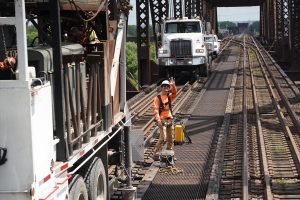
Tour attendees learned about the impact the TRRA investments will have on Chicago-St. Louis High Speed Intercity Passenger Rail Service. The start of 110 mph passenger rail service on the route kicked off at the end of June 2023, with the higher speeds eliminating approximately 15 minutes from the previous 90 mph runtimes between the two cities. With the additional TRRA improvements, the full build-out will result in double tracks for the entire length of the corridor reducing or eliminating the need for schedule-busting delays.
“It is important to continue investments in TRRA assets to ensure reliability and further reduce travel times, making intercity passenger rail service car competitive and giving riders a safe and environmentally friendly alternative,” said Brent Wood, President of TRRA.
The multimodal connectivity of the region was also featured as part of the tour. Several major road construction projects were highlighted along the way, including the $1.35 billion in improvements coming to the northern I-270 corridor running from Missouri to Illinois; almost $900 million in improvements coming to I-70, from Wentzville, Missouri, to the Stan Musial Veterans Memorial Bridge and the $305.5 million Relocated Illinois Rte. 3 project, which includes new construction of a four-mile corridor of Illinois Rte. 3 from River Park Connector in East St. Louis, Illinois, south to Monsanto Ave. in Sauget, Illinois. That fully funded project will decrease congestion, improve safety, address clearance issues and better accommodate freight and truck movements.
The rail freight tour rolled through the Ag Coast of America – home to 16 barge transfer facilities that, at total capacity, can handle more than 150 barges per day, providing the highest level of barge-handling capacity anywhere along the Mississippi River – before heading back across the Mississippi River into the State of Missouri via the MacArthur Bridge. TRRA is now working on a $57.6 million rehabilitation of this structure, which supports national freight movement and the future of farmers, manufacturers and distributors who depend on it. The bridge helps link America’s eastern and western freight rail networks and serves the six Class I Railroads and Amtrak.
The majority of the projects highlighted on the tour are included in the St. Louis Regional Freightway’s Priority Projects List, which includes more than 25 projects and represents the infrastructure needs of the manufacturing and logistics industries in the Eastern Missouri and Southwestern Illinois area.
Ed Hassinger, Deputy Director and Chief Engineer for MoDOT, talked about the importance of the St. Louis Regional Freightway’s list in advancing key infrastructure projects for the region. “I-270 was on the list, and we’re four months away from being done with that project. We have a partnership with IDOT on the Chain of Rocks Bridge and that’s under construction, and probably the biggest news is that (Missouri) Governor Parson is going to be signing the bill that authorizes the rebuilding of I-70 across the entire state – a $2.8 billion state investment,” said Hassinger. “Our governor and our legislators have infrastructure on their mind, and they are putting their money where their mouth is.”
Lamie tied the infrastructure investments back to the region’s exceptional industrial real estate market that reflects the benefits of the region’s forward thinking and great track record securing funding and positive outcomes.
“2022 was a record year in terms of industrial real estate construction with 7 MSF of industrial real estate coming on line and 6.5 MSF absorbed. 2023 so far includes 1.1 MSF delivered with 3.6 MSF still under construction,” said Lamie. “A majority of this construction is along sections of I-70/I-270 that includes recent funding announcements by MoDOT and IDOT and emphasizes the value of public and private sector leaders working together via the Freight Development Committee. Infrastructure investments along these corridors are supporting this industry and based on these statistics, the rate of return is worth the investment.”
To learn more about the Priority Projects List and the specific projects that encompass it, visit https://www.thefreightway.com/why-stl-region/priority-infrastructure-projects/.
Access photos from the tour here.

